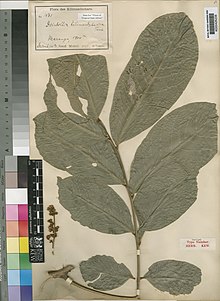mũhoko
Jump to navigation
Jump to search
Kikuyu[edit]

Alternative forms[edit]
Pronunciation[edit]
- As for Tonal Class, Benson (1964) classifies this term into Class 2 with a disyllabic stem, together with kĩgunyũ, njagĩ, kiugũ, and so on.
Noun[edit]
mũhoko class 3 (plural mĩhoko)
- endod, African soapberry (Phytolacca dodecandra;[1][2][3][4] though very poisonous, parts of this plant were traditionally used for treating cattle sickness and as aperient for human being.[2][4]
- soap berry (Deinbollia kilimandscharica)[2][4]
- Synonym: mũcanga-mũrĩo
Related terms[edit]
(Verbs)
References[edit]
- ↑ 1.0 1.1 Beentje, H.J. (1994) Kenya Trees, Shrubs and Lianas[1], Nairobi, Kenya: National Museum of Kenya, →ISBN
- ↑ 2.0 2.1 2.2 “mũhoko” in Benson, T.G. (1964). Kikuyu-English dictionary, p. 161. Oxford: Clarendon Press.
- ^ Kamau, Loice Njeri et al. (2016). "Ethnobotanical survey and threats to medicinal plants traditionally used for the management of human diseases in Nyeri County, Kenya". TANG 6(3): 10.
- ↑ 4.0 4.1 4.2 Leakey, L. S. B. (1977). The Southern Kikuyu before 1903, v. III, pp. 1334, 1341. London and New York: Academic Press. →ISBN